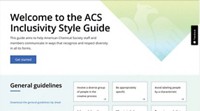Advertisement
Grab your lab coat. Let's get started
Welcome!
Welcome!
Create an account below to get 6 C&EN articles per month, receive newsletters and more - all free.
It seems this is your first time logging in online. Please enter the following information to continue.
As an ACS member you automatically get access to this site. All we need is few more details to create your reading experience.
Not you? Sign in with a different account.
Not you? Sign in with a different account.
ERROR 1
ERROR 1
ERROR 2
ERROR 2
ERROR 2
ERROR 2
ERROR 2
Password and Confirm password must match.
If you have an ACS member number, please enter it here so we can link this account to your membership. (optional)
ERROR 2
ACS values your privacy. By submitting your information, you are gaining access to C&EN and subscribing to our weekly newsletter. We use the information you provide to make your reading experience better, and we will never sell your data to third party members.
Diversity
Discussing demographic data and race, ethnicity, and nationality
As numerous organizations request demographic information, doing so respectfully is of utmost importance
by Racquel Jemison, ACS staff
September 29, 2023
| A version of this story appeared in
Volume 101, Issue 32

After the summer of 2020, many organizations and institutions in the US began to reckon with systemic racism. For some, the protests against violent and biased policing brought new awareness to the ways in which corporations have excluded Black people and other people of color from leadership ranks or even participation. Some of those organizations committed to tracking hiring, promotions, and retention rates of Asian, Black, Hispanic, Indigenous, and Latine people. Some also began to share the makeup of their boards, senior leadership, audiences, and member bases.
The first report on these measures within the American Chemical Society was the Publications Division’s Diversity Data Report 2022. ACS Publications committed to gathering baseline statistics on diversity—specifically, tracking participation based on gender, race, and geography (people in countries and regions other than the US, East Asia, and western Europe). The Publications Division also launched several initiatives to increase diverse participation among authors, editors, and reviewers.
Data tracking calls to question the complexities of gathering and reporting data on demographic characteristics: When does it make sense to ask about identity? Which groups and subgroups should you include? How do you capture people with multiple identities? How can you report transparently and maintain confidentiality for small groups of people?
Evolving societal conditions are another factor that makes data tracking challenging. Changes in language, shifts in policy, and how society discusses and considers race, gender, and sexual orientation can greatly affect how people respond to survey questions and self-identify. For example, according to a 2021 Gallup poll, people born between 1997 and 2012 are more likely than older generations to report being LGBTQ+. There have also been increases in the number of people that identify as Indigenous on the US Census, and that change cannot be explained by a population increase alone.
Asking for demographic information respectfully and inclusively can be challenging. While there is no single method to ask these questions, there are some general principles that can help when crafting forms and surveys. You can find these principles in the “Forms” section of the ACS Inclusivity Style Guide, which serves as an educational resource to help with decision-making in communication. Although the section on forms is undergoing revision to better reflect lessons from the new data visualization section, its top recommendations are collected in a tip sheet, which you can access in this issue of C&EN or on the main guide website, www.acs.org/inclusivityguide.
The ACS Inclusivity Style Guide can also help you communicate inclusively about race, ethnicity, and nationality from a US English–speaking lens. The recommendations are based on a number of guidelines from various organizations, institutions, and advocacy groups. The guide discusses when it might be appropriate to mention someone’s race, ethnicity, and nationality and which terms are most appropriate.
The tip sheet on race, ethnicity, and nationality is also included in this issue of C&EN and on the Inclusivity Style Guide website. It shares quick evergreen recommendations and context for some of the terms currently used, including information that might influence the selection of one term over another. For example, the guide defines the difference between the terms Hispanic and Latino and shares context on the terms Latinx and Latine. Writing about, reporting on, and navigating these conversations can be challenging. The guide aims to help simplify some of those decisions.
These tip sheets are being published in C&EN as part of a six-part series. As language continues to evolve, we urge you to share feedback or ideas on additions to the guide by emailing ISG@acs.org.
MORE ONLINE
Like what you’ve read? See the full guide and the most up-to-date tip sheets from the American Chemical Society at www.acs.org/inclusivityguide.
Forms
For more context, review the “Forms” section of the Inclusivity Style Guide. Use this tip sheet in combination with the “General guidelines” tip sheet.
State the purpose of providing the information
Clarifying why you’re asking for personal information can make people more comfortable answering.
State a commitment to privacy and nondiscrimination
Before questions about personal information, state that the organization will keep information private and will not discriminate on the basis of the information.
Allow opt-out and write-in options
Whenever possible, allow people the option to not answer questions about their personal information, such as gender or race, and to provide self-descriptions.
Allow for multiple responses
Recognize when people might have multiple answers to questions, such as multiple races and ethnicities.
Use inclusive orders and language
Be aware of how the order of options may signal a hierarchy of values. Avoid the term “Other” as a response option.
Race, ethnicity, and nationality
For more context, review the “Race, ethnicity, and nationality” section of the Inclusivity Style Guide. Use this tip sheet in combination with the “General guidelines” tip sheet.
Be specific
Racial and ethnic categories are incredibly broad. Being specific is clearer and avoids homogenizing a diverse group.
Use with care
- People of color: Think about what level of specificity is appropriate. If referring to the shared experiences of many people of diverse races and ethnicities who are not White, then this might be appropriate. If not, name the races and ethnicities.
- Underrepresented: Use the term only when a comparison exists and only when people are truly underrepresented (for example, in some sciences, not all people of color are underrepresented). Specify what category is underrepresented.
Avoid
- BIPOC, BAME, POC: Avoid using the abbreviations “BIPOC” (Black, Indigenous, and people of color), “BAME” (Black, Asian, and minority ethnic), and “POC” (people of color). Be specific when possible.
- Brown: Avoid because it has no clear definition. An exception is if someone identifies as Brown and it is important to mention their race.
- Minorities, non-White: “Minorities” is often used inaccurately, and both terms have the connotation of being lesser than.
- Caucasian: The term was originally used to reinforce inaccurate beliefs in natural racial categorizations. It is not a synonym for “White.”
Know the language
- American Indian and Native American: Follow a person’s or group’s preference on which term to use. Use a specific nation’s name when possible.
- Asian: Avoid using “Asian” to refer to a specific Asian population, such as East Asian people.
- Black and African American: “Black” is a broader term that includes those who aren’t US citizens. Use “Black” if you aren’t sure of someone’s preference.
- Hispanic and Latino: Hispanic people are of Spanish-speaking origin, whereas Latino people have a Latin American origin. The terms are not interchangeable, although there is overlap.
- Latinx: A gender-neutral alternative to “Latina” or “Latino.” There is a lot of disagreement over use of the word.
ACS Inclusivity Style Guide Tip Sheets
- Part 1: “General guidelines” and “Narratives, framing, and sentence structure”
- Part 2: “Forms” and “Race, ethnicity, and nationality”
- Part 3: “Images” and “Data visualization”
- Part 4: “Accessibility” and “Disabilities, disorders, and other health conditions”
- Part 5: “Socioeconomic status” and “Age”
- Part 6: “Gender and sexuality” and “Body size”






Join the conversation
Contact the reporter
Submit a Letter to the Editor for publication
Engage with us on Twitter